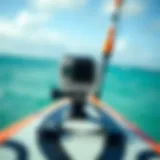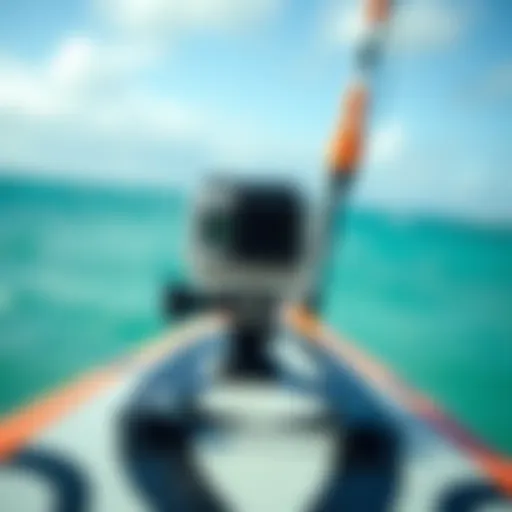Explore Top Windfoils for Sale: Your Ultimate Guide
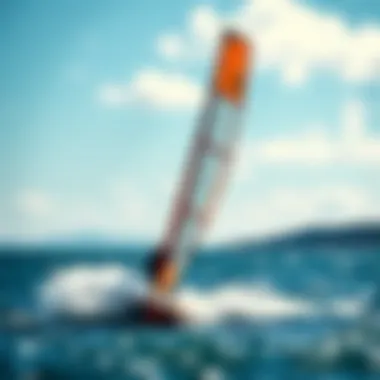

Intro
When it comes to kiteboarding, the equipment you choose can make or break your experience. One of the latest innovations taking the kiteboarding world by storm is the windfoil. As many enthusiasts can attest, windfoils add a new dimension to the sport, allowing riders to experience a unique blend of speed and agility on the water. This guide aims to delve into the intricacies of selecting the right windfoil, understanding its components, and fine-tuning your skills to harness the full potential of this fascinating gear.
Whether you're just starting out or are a seasoned kiteboarder, navigating the world of windfoils can feel daunting. Factors such as design, material, and size all influence performance, making the selection process anything but straightforward. For those who seek not only to ride but to glide above the surface, understanding these elements is essential.
The following sections will lay out the necessary considerations in gear selection, as well as explore skill development crucial for mastering windfoiling. So, let’s dive into the details and prepare you for an exhilarating experience on the water.
Gear Selection
In the realm of windfoiling, choosing the right gear is akin to picking the perfect dance partner. You want harmony between rider and equipment, ensuring that every move is fluid and effortless. Here, we'll break down essential components that will guide both novice and experienced kiteboarders in their purchasing decisions.
Types of Kites
Finding the right kite can either amplify your experience or leave you struggling against the wind. Generally, the choice comes down to two main types: sled kites and delta kites. Here’s a closer look:
- Sled Kites: Known for their simplicity and stability, sled kites are great for beginners. They perform well in a variety of wind conditions and are relatively easy to control.
- Delta Kites: These kites feature a triangular shape that enhances performance and maneuverability. While they can be more challenging to handle, many advanced riders prefer them for their speed and agility.
It's vital to choose the kite that aligns with your skill level and intended use. Factors such as wind speed, riding style, and personal preferences should all influence your decision.
Choosing the Right Board
Equally critical is the kiteboarding board used with the windfoil. Boards vary greatly in design and size, impacting how the rider interacts with the water. When selecting a board, various features come into play:
- Size: A larger board can provide more stability and buoyancy, which is particularly advantageous for beginners. Meanwhile, smaller boards often lend themselves to better performance in trick riding.
- Material: Lightweight materials such as carbon fiber can contribute to speed but may come at a higher cost. Durability versus weight is a key consideration as well.
- Shape: Different board shapes cater to different styles; for example, a rounded nose can ease the learning curve by providing better maneuverability.
Choosing a board is not just about comfort—it’s about how it completes the synergy of rider and kite. As you evaluate options, consider how each element aligns with your personal style and riding preferences.
"The key to enjoying windfoiling lies in the perfect match between rider and gear. Each choice plays a pivotal role in mastering the art of gliding across the waves."
Navigating the choices available can be a bit of a labyrinth, but doing your homework will pay off in spades. With each decision, reflect on what kind of kiteboarding experience you desire—speed, performance, or an easy learning curve.
Next, we will explore the skills necessary for mastering your gear, ensuring you can ride the wind with confidence and finesse. Stick around as we break down essential techniques to elevate your windfoiling experience.
Prelims to Windfoils
Windfoiling, a sport that combines windsurfing and kitesurfing elements, has gained much traction in recent years. This section aims to shed light on the vital components surrounding windfoils, providing insights that can significantly enhance one's experience on the water. Understanding windfoils isn't just for enthusiasts looking to buy; it’s essential for those wanting to deepen their knowledge of what this exciting activity entails.
Sales of windfoils are continuously increasing as more people recognize their advantages and unique capabilities. Thus, it’s crucial to not only explore the basics but also the elements that contribute to the efficacy and excitement of windfoiling.
Understanding Windfoiling
Windfoiling involves riding a surfboard lifted above the water’s surface by a hydrofoil. The hydrofoil consists of a long, slender mast attached to a board and wings underneath the water. This system allows it to be lifted out of the water, gliding effortlessly along the surface, providing a unique sensation and sensation of speed.
For beginners, the thought of gliding above the water may seem daunting. However, once one gets the hang of it, the feeling is exhilarating. Practically, windfoiling allows riders to skim over water even in lighter wind conditions, giving them a broader range of sail days compared to traditional windsurfing.
History and Development
The concept of windfoiling isn’t entirely new; it draws influence from various sailing techniques. The origins can be traced back to experimental designs in hydrofoil technology from the mid-20th century, but it remained in relative obscurity for decades. It wasn’t until the early 2000s, when advancements in materials and design made it more accessible, that windfoiling began to gain popularity.
The foiling community has developed in leaps and bounds, thanks to contributions from a myriad of designers and brands. Significant milestones in the design of windfoils include the introduction of carbon fiber masts and wings that enhanced performance, making them lighter and more responsive. Riders can now find a range of options specializing for freeriding or racing, making it easier than ever for both novices and experienced riders to find their fit.
In summary, the history behind windfoiling paints a picture of innovation and evolution. As more people turn to this unique aspect of kiteboarding, understanding its roots can deepen one’s appreciation for the sport and its numerous benefits.
Types of Windfoils
Understanding the types of windfoils is essential for anyone looking to dive into the world of windfoiling. The diversity in designs caters to various styles and skill levels, making it crucial to choose the right foil that matches one's riding preferences. Each type of windfoil offers distinct characteristics that can significantly impact performance and enjoyment. As we explore the different categories—freeride, racing, and surf and freestyle—you'll notice how these options can enhance your time on the water.
Freeride Windfoils
Freeride windfoils are designed for versatility and user-friendliness. They typically feature a larger surface area, which provides better lift and stability, making them perfect for riders looking to cruise comfortably. This type of windfoil is suitable for those who prefer relaxed sessions, allowing new riders to build confidence while providing seasoned enthusiasts with a chance to explore various riding styles.
Benefits of Freeride Windfoils:
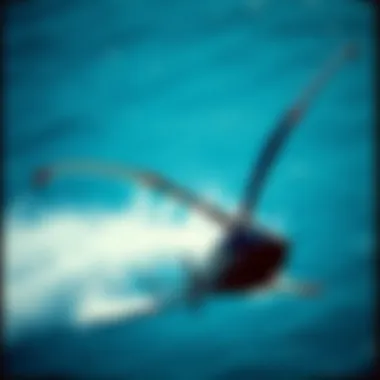

- Stability: Their design offers stability in different wind conditions.
- Ease of Use: Suitable for beginners due to easier handling.
- Versatile Riding: Perfect for casual cruising and light freestyle maneuvers.
Freeride windfoils often come equipped with larger wings and a wider wingspan, facilitating smooth lift-off from the water. Riders can expect a gentle glide, making it easier to keep control in choppy conditions. This is especially appealing for those just starting out or wanting to relax after a long day.
Racing Windfoils
Racing windfoils, in contrast, are engineered for speed and performance. These foils are built with a focus on maximizing efficiency and minimizing drag. They usually have a smaller surface area and a more refined shape, allowing for rapid acceleration and high top speeds. Ideal for competitive riders, racing foils can dramatically enhance performance in events.
Key Characteristics of Racing Windfoils:
- Speed Optimization: Slim design reduces drag, improving speed.
- Agility: These foils allow for quick turns and precise handling.
- Competitive Edge: Best suited for racing events where performance is critical.
For racing enthusiasts, investing in a racing windfoil can be a game-changer during competitions. The ability to achieve faster speeds and tight turning radii defines one's positioning in a race, making the right choice crucial for serious competitors.
Surf and Freestyle Windfoils
This category focuses on dynamic movements, perfect for wave riding and freestyle tricks. Surf and freestyle windfoils typically feature a mixed design that encourages playful riding styles. These foils manage to combine lift and responsiveness, allowing riders to jump and perform intricate maneuvers in the surf or flat water.
Why Choose Surf and Freestyle Windfoils:
- Freestyle Maneuverability: Designed for jumping, spinning, and tricks.
- Wave Adaptation: Excellent for managing the challenges of waves.
- Lightweight Design: Often constructed with lightweight materials for better control.
Riders often enjoy the blend of stability needed for jumping while still having the agility to navigate waves. If surfing is your focus or you just want to spice up your freeride sessions with tricks, consider investing in a surf and freestyle windfoil.
"Choosing the right windfoil type is not merely a matter of preference; it can shape the entire experience on the water. Select wisely!"
By understanding the characteristics of each windfoil type, riders can make an informed choice that aligns with their skills and riding goals. Whether cruising on a freeride foil or performing tricks on a surf and freestyle model, the right type makes all the difference in your overall experience.
Key Features to Consider
When stepping into the world of windfoiling, it's essential to grasp the key features that influence performance and enjoyment. Each facet of a windfoil—from its material composition to its weight—plays a crucial role in determining how well it performs in various conditions. Understanding these elements helps riders, regardless of their expertise level, make an informed decision that aligns with their specific needs and riding styles.
Material Composition
The materials used in a windfoil can dramatically impact its performance and durability. Most windfoils are constructed from a combination of aluminum, carbon fiber, and fiberglass.
- Aluminum: Often used for its affordability and strength, aluminum foils are robust but may be heavier than their carbon counterparts. They effectively handle various conditions but might not offer the same level of responsiveness.
- Carbon Fiber: Known for being light and strong, carbon fiber foils provide better performance, particularly in speed and maneuverability. However, they come at a higher price point.
- Fiberglass: Typically considered an entry-level material, fiberglass is less expensive and can be quite durable. It's a solid choice for beginners still honing their skills.
Understanding these materials will aid you in identifying the best windfoil suitable for your riding style and budget.
Foil Size and Shape
The size and shape of a windfoil significantly influence how it interacts with water and the wind. It can affect everything from lift to stability.
- Wing Size: Larger wings generate more lift at lower speeds, making them ideal for beginners. They provide stability, helping riders feel more secure while they learn.
- Shape Variations: Foils can have different shapes, such as Tuttle and plate designs. Tuttle foils are often easier to maneuver, whereas plate designs can provide better control.
- Aspect Ratio: A higher aspect ratio foil is narrower and longer, which can increase speed efficiency but may require more skill to control. Conversely, a lower aspect ratio wing offers greater stability, making it easier for novice riders.
Paying attention to these characteristics will help ensure a fitting choice according to your experience and preferences.
Weight and Balance
The overall weight and balance of a windfoil can greatly affect its control and responsiveness.
- Weight Considerations: A lighter foil offers better responsiveness, allowing for quicker turns and a more exhilarating ride. As a general rule, lighter materials reduce drag and enhance performance.
- Center of Gravity: Understanding the balance between the wing and the mast is crucial. If your windfoil is nose-heavy or tail-heavy, it could lead to difficulties in maintaining stability and control.
- Personal Impact: The rider's weight also plays an integral role in selecting the right windfoil. It's critical to choose a foil that can handle and adapt to your individual weight for optimal performance and safety.
A well-balanced windfoil not only empowers you to navigate through waves but also enhances your overall riding experience, contributing to days filled with smooth sailing.
By carefully considering these features—material composition, foil size and shape, and weight and balance—you can make a more educated decision in your windfoil purchase. The right foil can mean the difference between cruising with grace and struggling against the wind.
Market Trends in Windfoils
Understanding market trends in windfoils is crucial for kiteboarding enthusiasts who want to make well-informed purchasing decisions. The windfoiling industry, like many sports, is in a constant state of flux. New brands emerge, designs evolve, and consumer preferences shift. Keeping a finger on the pulse of these trends can equip potential buyers with valuable insights that ultimately enhance their riding experience.
One of the principal elements to consider in the context of market trends is the rapid pace of innovation. Companies are consistently developing new technologies and refining existing designs to improve performance and durability. . For instance, the integration of lightweight materials like carbon fiber is making newer foils both stronger and more responsive. With this type of innovation, riders find themselves able to achieve higher speeds and better control over their maneuvers.


Emerging Brands and Innovations
In recent years, some innovative brands have entered the windfoiling arena, disrupting traditional market leaders. Slingshot, for example, has gained a reputation for its high-quality foils that blend performance and accessibility. Meanwhile, newer brands like Moses and Kitefoil are pushing boundaries with designs that cater to specific user needs—be it freeriding or performance racing. Each brand introduces unique shapes and sizes of foils catering to different styles and skill levels.
- Slingshot: Known for customizable options, aiming at both beginner and expert riders.
- Moses: Focused on high-end technology with an eye on weight reduction.
- Kitefoil: Offers competitive pricing while maintaining quality and performance.
Additionally, many of these emerging brands leverage direct-to-consumer models, allowing them to provide better prices by cutting out the middleman. This shift not only disrupts traditional retail but also encourages healthy competition, ultimately benefiting the consumer.
The influences of sustainability on product development cannot be overstated. Brands are now increasingly adopting eco-friendly materials and production processes, responding to a growing consumer base concerned with the environmental impact of their hobbies. This mindset is not just a trend but a movement that appeals to environmentally-conscious riders looking for sustainable options without compromising on performance.
Price Range and Value Analysis
When it comes to purchasing windfoils, understanding the price range and the corresponding value is essential. Prices can vary significantly based on a multitude of factors—brand reputation, materials utilized, and specific features offered.
On the lower end of the spectrum, beginner windfoils usually range from $600 to $1,200. Such models may lack some advanced features but provide a solid introduction to the sport. In contrast, professional-grade windfoils can cost upwards of $2,000 to $3,500, often incorporating cutting-edge technology and high-performance materials designed for competitive sailing.
When evaluating the price:
- Budget Consideration: Determine what you can afford without breaking the bank.
- Longevity vs. Initial Cost: Sometimes, spending a bit more upfront can lead to savings over time due to durability and performance.
- Resale Value: A well-regarded brand may retain its value better, making it a smarter investment.
Purchasing Windfoils
Buying a windfoil is more than just a step in your kiteboarding journey; it’s about choosing the right equipment that fits your style, skill level, and the way you wish to ride the waves. This section addresses the important aspects of purchasing windfoils, covering where to buy them and how to evaluate sellers.
Where to Buy
Retail Stores
When considering purchasing a windfoil, retail stores often stand out because they allow you to physically inspect the equipment. Customers can touch the materials, check the weight, and even ask specific questions to knowledgeable staff. Many windsurfing shops offer an array of selections and demo models, giving you a chance to test them out before making a final decision.
One significant advantage of retail stores is the instant gratification; you can leave with your new gear right after the purchase. Additionally, they often provide local tips and information tailored to the area, which is an invaluable asset for both beginners and seasoned kiteboarders. However, it's worth noting that the price at these physical locations can be slightly higher than what you might find online due to overhead costs.
Online Platforms
The rise of online shopping has made it increasingly popular for kiteboarders to browse and buy windfoils from the comfort of their homes. Websites like Amazon, eBay, or specialized kiteboarding retailers often have a broad selection and competitive pricing. One of the key characteristics of online platforms is the ease of comparison shopping: you can quickly check multiple sites for the best deals or read reviews without leaving your couch.
Online shopping also opens up access to brands that may not have physical stores in your area. However, with this convenience comes the trade-off of not being able to physically examine the windfoil beforehand. There’s also the possibility of receiving an item that doesn't match the description, which could lead to challenges in returning or exchanging the product.
Local Kiteboarding Shops
Local kiteboarding shops present a unique blend of benefits, combining the knowledge of retail stores with some advantages of online shopping. Often run by passionate enthusiasts, these shops provide not just products but a community feel to the sport. They may offer workshops, clinics, and demo events that allow you to learn more and connect with other kiteboarders.
Moreover, local shops usually have a strong understanding of the regional wind and water conditions, helping you choose the perfect windfoil that matches your local environment. Conversely, their inventory may be more limited than what’s available online, and sometimes prices can be less competitive due to the smaller scale of their operations.
Evaluating Sellers and Reviews
After narrowing down your options on where to purchase a windfoil, it’s crucial to evaluate the sellers you’re considering. Reading customer reviews can provide insight into customer experiences, product quality, and the seller's reliability.
- Look for sellers with positive reviews specifically mentioning the quality of their products.
- Check if the sellers are responsive to customer inquiries and issues. This can be a telling sign of their customer service commitment.
- A reputable seller often has a clear return policy, giving you peace of mind in case the product doesn't meet your expectations.
Ultimately, a combination of careful consideration, researching multiple sources, and engaging with the community will guide you toward making the best decision in purchasing your windfoil.
Care and Maintenance
Caring for your windfoil is an often understated part of enjoying this exhilarating sport. While the adrenaline rush of gliding above the water is thrilling, proper care means your equipment will last longer and perform better. An investment in good upkeep saves future hassle and cash, ensuring your time on the water remains uninterrupted.
Cleaning and Storage
Keeping your windfoil clean is integral to maintaining its performance. Saltwater and sand can wreak havoc on the gear if they are left untreated. Here are some crucial steps for cleaning:
- Rinse after each use: After you finish your session, it’s wise to immediately rinse your windfoil with fresh water. This simple action removes salt and debris which, over time, can corrode materials and lead to wear and tear.
- Use a mild soap: For a deeper clean, apply a gentle soap along with water. This can effectively lift stubborn grime and dirt that adherence to your foil. Just remember to rinse thoroughly.
- Dry properly: Once cleaned, lay your windfoil flat on a soft surface and let it dry completely. Avoid direct sunlight, as it might damage certain materials and accelerate wear.
- Store in a cool, dry place: Proper storage is just as important as cleaning. Keep your windfoil in a climate-controlled environment to prevent warping or moisture buildup. Use a dedicated bag to protect it from dust, accidental bumps, and the like.
"All good things come to those who take care of them." A simple adage, but it rings oh-so-true in the windfoiling world.
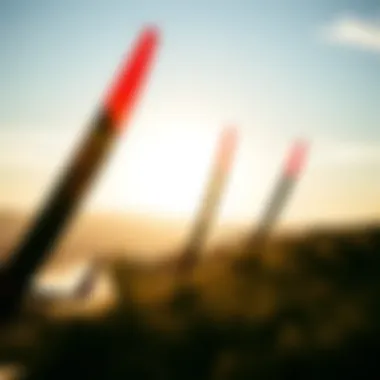

Repairing Common Damage
Although windfoils are built to withstand forceful winds and waves, they aren’t immune to damage. The elements can sometimes take a toll, leading to common issues such as scratches, dings, or in worse cases, cracks. Here are some tips on how to tackle repairs:
- Assess the damage: First things first—determine how serious the issue is. Minor scratches can often be polished out while cracks might require more serious attention.
- Use epoxy for cracks: If a crack occurs, a marine epoxy can often be your best friend. Apply it according to the instructions provided, ensuring the area is clean and dry.
- Sand out scratches: For minor scratches, use fine-grit sandpaper, rubbing in the direction of the scratch to smooth over the surface. This can restore some of the original sheen.
- Regular inspections: Make it a habit to inspect your windfoil regularly. Early detection of issues may help prevent costly repairs down the line.
Taking the time to clean and properly maintain your windfoil isn’t just about preserving equipment; it’s about enhancing your overall experience on the water. Engaging in these practices will not only prolong the life of your gear but also ensure that, when you do hit those waves, you can focus on the thrill of the ride.
Safety Considerations
When it comes to windfoiling, safety is not something to skimp on. If you're new to the sport or a seasoned rider, understanding safety considerations is critical. It’s all about ensuring an enjoyable experience while minimizing risks.
Wearing Proper Gear
Safety starts with the right gear. Just like a knight wouldn't head for battle without armor, you shouldn't hit the water unprepared. Here’s a rundown of essential windfoiling gear:
- Helmet: A good helmet protects your head from unexpected tumbles. It can be a lifesaver in rough conditions.
- Impact Vest: This helps bolster your torso against falls and provides an extra layer of buoyancy. Some vests even have pockets for adding flotation inserts.
- Booties or Shoes: These offer grip on your board and protect your feet from sharp objects. The right pair makes all the difference!
- Wetsuits or Drysuits: Depending on the water temperature, a wetsuit keeps you warm, while a drysuit keeps you completely dry. Both protect against abrasions and cold water shock.
There’s an old saying, "Better safe than sorry." In windfoiling, that couldn’t ring truer. Investing in quality gear may cost a bit more upfront, but it can save you from serious injuries and keep you riding longer.
Understanding Local Regulations
Hitting the water without knowing local regulations is like driving without a map—you risk getting lost or, worse, fined. Each location may have its own rules that govern where and how you can windfoil. Here are a couple of common regulations to keep in mind:
- Restricted Zones: Some areas may have marked zones where windfoiling isn’t allowed, often due to safety concerns with other watercraft or swimmers.
- Vessel Right of Way: Just like on the road, some rules dictate who has the right of way on the water. Familiarize yourself with these to avoid dangerous run-ins with boats.
- Local Events and Permits: Sometimes, special events might require permits or have specific rules for safety or environmental protection.
Keep in mind that ignorance of the law is no excuse. Not only can fines spoil your fun, but violating rules can also endanger you and others.
Environmental Impact
The conversation surrounding windfoils isn't solely about the thrill of gliding over water or carving through waves. It extends into the realm of environmental considerations, an area where enthusiasts and manufacturers alike increasingly recognize the significance of sustainable practices. As the popularity of windfoiling grows, so does the imperative to reflect on how this sport interacts with our planet.
Sustainable Practices
Embracing sustainable practices when it comes to windfoils requires thoughtful integration of eco-friendly materials and processes into manufacturing. Most companies now strive to reduce their carbon footprint while ensuring durability and performance of the product. Here are a few sustainable practices being adopted:
- Recyclable Materials: Many manufacturers are looking into using recyclable materials for their windfoils. This means that once the gear has been retired, parts of it can be repurposed instead of ending up in landfills.
- Local Sourcing: Companies are focusing on sourcing materials locally to minimize transportation emissions. By doing so, they not only support local economies but also lessen the environmental impact associated with long-distance shipping.
- Eco-Friendly Manufacturing: Some brands take pride in adopting green technologies in their manufacturing process. For instance, using renewable energy sources for production decreases reliance on fossil fuels.
Moreover, responsible windfoiling includes maintaining the foils and kites to prolong their lifespan, reducing waste. It's also incalculably important for riders to invest in gear that adheres to sustainable standards, fostering a culture of appreciation and care for the environment.
Minimizing Footprint
In the grand scheme of things, windfoiling enthusiasts can contribute positively to environmental conservation by being aware of their practices and choices. To minimize their ecological footprint, here are some actionable strategies:
- Choose Green Brands: By selecting brands that prioritize sustainable practices, consumers drive demand for environmentally-friendly products. Validate the claims through certification or indications of eco-conscious initiatives.
- Educate Yourself: Knowledge is power. Understand the local ecosystem and how it can be adversely affected by outdoor activities. Being informed about regulations and protected areas can help adventurers tread more lightly.
- Embrace Nature-Friendly Locations: Navigating water bodies that have healthy ecosystems and practicing good etiquette ensures that you're not contributing to the degradation of natural habitats. This means avoiding areas where wildlife is nesting or migrating.
- Engagement in Clean-Up Initiatives: Participating in beach clean-ups or organizing local events that focus on protecting marine environments demonstrates a commitment to sustainability. Not only does it benefit nature, but it also strengthens the community bond.
Ultimately, the responsibility rests not just on the industry but on every kiteboarder and windfoiling enthusiast. When each person chips in, the cumulative impact can lead to significant change, preserving those beautiful wind-swept waters for future generations.
"Small actions can lead to big change; it may be one foil at a time, but collectively, we can shift tides."
Being conscientious in the choices made on the water ensures that windfoiling remains a thrilling yet sustainable pursuit. For more on windfoil environmental impact, you may visit Wikipedia or check Britannica.
Lastly, it might be beneficial to follow discussions and communities on platforms like Reddit to keep informed about sustainable practices and innovations in windfoiling.
Epilogue
In wrapping up our exploration into the world of windfoils, it's clear that this innovative equipment plays a crucial role in enhancing the kiteboarding experience. As we've discussed throughout this guide, understanding the different types of windfoils, their features, and the market trends equips enthusiasts with the knowledge necessary to make informed purchasing decisions. When it comes to exploring the vast waters, the right windfoil can dramatically affect both performance and enjoyment.
Final Thoughts on Windfoiling
Windfoiling isn't just a fleeting trend; it's a transformation in water sports. Choosing the right foil can be a game-changer, enabling riders to glide effortlessly over the water, experiencing the thrill that comes from harnessing wind energy.
"A good windfoil not only supports your skills but elevates your entire riding experience."
Here are some important elements to consider:
- Adaptability: Different windfoils cater to various styles, from freeriding to racing.
- Maintenance: Keeping your gear in tip-top shape ensures longevity and optimal performance.
- Safety: Awareness of gear and local regulations safeguards both the rider and the environment.
In short, whether you’re a newbie or a seasoned expert, diving into windfoiling presents an exciting avenue to expand your kiteboarding horizons. The information shared here empowers you to make thoughtful decisions, ultimately enriching your relationship with this exhilarating sport. As you gear up and hit the water, remember: it's not just about the ride; it's about the love for the wind and waves.
